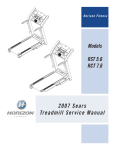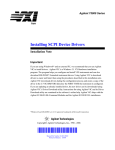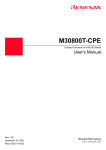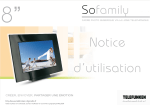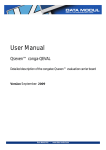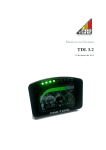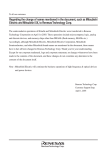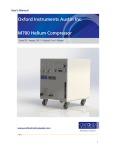Download [S30830T-CPE] Users Manual: CPE83SUE
Transcript
M32C/83 Compact Emulator S30830TS30830T-CPE Compact Emulator with Real-time Trace User’s Manual Sunny Giken Inc. S30830T-CPE User’s Manual Keep safety first in your circuit designs! • Sunny Giken Inc. puts the maximum effort into making semiconductor products better and more reliable, but there is always the possibility that trouble may occur with them. Trouble with semiconductors may lead to personal injury, fire or property damage. Remember to give due consideration to safety when making your circuit designs, with appropriate measures such as (i) placement of substitutive, auxiliary circuits, (ii) use of non-flammable material or (iii) prevention against any malfunction or mishap. Precautions to be taken when using this manual • These materials are intended as a reference to assist our customers in the selection of the Sunny Giken Inc. product best suited to the customer’s application; they do not convey any license under any intellectual property rights, or any other rights, belonging to Sunny Giken Inc. • Sunny Giken Inc. assumes no responsibility for any damage, or infringement of any third-party’s rights, originating in the use of any product data, diagrams, charts, programs, algorithms, or circuit application examples contained in these materials. • All information contained in these materials, including product data, diagrams, charts, programs and algorithms represents information on products at the time of publication of these materials, and is subject to change by Sunny Giken Inc. without notice due to product improvements or other reasons. It is therefore recommended that customers check the latest product information and pay attention to the information published by Sunny Giken Inc. in various means, including Sunny Giken Homepage (http://www.sunnygiken.co.jp/english/) before purchasing a product listed herein. • Sunny Giken Inc. assumes no responsibility for any damage, liability or other loss resulting from the information contained herein. • When using any or all of the information contained in these materials, including product data, diagrams, charts, programs, and algorithms, please be sure to evaluate all information as a total system before making a final decision on the applicability of the information and products. Sunny Giken Inc. assumes no responsibility for any damage, liability or other loss resulting from the information contained herein. • All products of Sunny Giken Inc. are not designed or manufactured for use in a device or system that is used under circumstances in which human life is potentially at stake. Please contact Sunny Giken Inc. when considering the use of a product contained herein for any specific purposes, such as apparatus or systems for transportation, vehicular, medical, aerospace, nuclear, or undersea repeater use. • The prior written approval of Sunny Giken Inc. is necessary to reprint or reproduce in whole or in part these materials. • If these products or technologies are subject to the Japanese export control restrictions, they must be exported under a license from the Japanese government and cannot be imported into a country other than the approved destination. Any diversion or reexport contrary to the export control laws and regulations of Japan and/or the country of destination is prohibited. • Please contact Sunny Giken Inc. for further details of these materials or the products contained therein. Precautions to be taken when using this product • This product is a development support tool you can use in your program development and evaluation steps. When development of your program is completed, always be sure to verify its operation by board-based evaluation and test before putting it into mass production. • Sunny Giken Inc. will not assume any responsibility for the results arising from the use of the product. • Sunny Giken Inc. will respond to customer requests for the product, with expenses borne by Sunny Giken Inc. or the customer, as follows: (1) Repair or replacement of the product when it is found faulty (2) Modification of nonconformity when the product contains nonconformity • This product has been developed by assuming its use for program development and evaluation in laboratories. Therefore, it does not fall under the application of electrical equipment control laws and protection against electromagnetic interference when used in Japan. Contact point for inquiries of the contents of the product and manual manual For inquiries about the contents of the product or this manual, fill in the "Technical Support Application Form" included in the manual and fax it to our dealer, Mitsubishi Electric Corporation’s technical support desk. When sending email, write the same items of the "Technical Support Application Form" and send it to Mitsubishi Electric Corporation’s support desk ([email protected]). [Maker] S Sunny unny Giken Giken Inc. [Dealer] Mitsubishi Electric Corporation [Technical Support] Support] [email protected] [User [User Registration] Registration] [email protected] [Homepage] Homepage] http://www.sunnygiken.co.jp http://www.sunnygiken.co.jp/english sunnygiken.co.jp/english/ /english/ (1/57) Preface Thank you for purchasing the S30830T-CPE. The S30830T-CPE is a compact emulator with the real-time trace function for the M32C/81, M32C/82, and M32C/83 Groups. This User’s Manual mainly describes specifications of the S30830T-CPE and how to set up and operate it. For details of the following products, which are used with the S30830T-CPE, refer to each product's online manual. • Emulator debugger: PD308S • C compiler: NC308WA Entry Version. • Integrated development environment: TM If there is any question or doubt about this product, contact Sunny Giken Inc.. ●For the latest information, please access to the below homepage address. The latest information on the S30830T-CPE Emulator hardware and debugger PD308S is available. http://www.sunnygiken.co.jp/english/830tcpe-products-e.html To use he product properly Precautions for Safety •In both this User’s Manual and on the product itself, several icons are used to insure proper handling of this product and also to prevent injuries to you or other persons, or damage to your properties. •The icons' graphic images and meanings are given in "Chapter 1. Precautions for Safety". Be sure to read this chapter before using the product. (2/57) S30830T-CPE User’s Manual Terminology Some specific words used in this User’s Manual are defined as follows: • Emulator This means the S30830T-CPE (this product). • Emulator system This means an emulator system built around the S30830T-CPE emulator. The S30830T-CPE emulator system is configured with an emulator, host machine and emulator debugger. • Host machine This means a personal computer used to control the emulator. • Emulator debugger This means a software tool, PD308S to control the emulator from the host machine through an communications interface. • Evaluation MCU This means the microcomputer mounted on the emulator which is operated in the specific mode for tools. • Target MCU This means the microcomputer you are going to debug. • Target system This means an Operation application system using the microcomputer to be debugged. • ‘*’ after a signal name The symbol "* " that is put after a signal name is used to show active LOW. (e.g.RESET* :Reset signal.) (3/57) Contents CHAPTER 1. PRECAUTIONS FOR SAFETY .................................................................................................................... 6 1.1 SAFETY SYMBOLS AND MEANINGS .................................................................................................................................. 7 CHAPTER 2. USAGE ......................................................................................................................................................... 14 2.1 NAME OF EACH PART ................................................................................................................................................... 15 (1) System Configuration................................................................................................................................................ 15 (2) Name of Each Part of Emulator................................................................................................................................ 16 2.2 STARTING UP THE EMULATOR ...................................................................................................................................... 18 2.3 EMULATOR INITIAL SETUP ........................................................................................................................................... 19 (1) Selection Switch......................................................................................................................................................... 19 2.4 CONNECTING THE EMULATOR SYSTEM ......................................................................................................................... 20 (1) Connecting the PC Connecting Cable....................................................................................................................... 20 (2) Connecting the DC Cable .......................................................................................................................................... 20 2.5 CONNECTING THE TARGET SYSTEM (AS OCCASION DEMANDS) ....................................................................................... 21 (1)Connecting to the 100 Pin LCC Socket...................................................................................................................... 21 2.6 TURNING ON THE POWER............................................................................................................................................. 23 (1) Checking the Connection of the Emulator System .................................................................................................. 23 (2) Turning On the Power ............................................................................................................................................... 23 2.7 LED DISPLAY WHEN THE EMULATOR STARTS UP NORMALLY ...................................................................................... 23 2.8 STARTING UP EMULATOR DEBUGGER PD308S............................................................................................................. 24 2.9 SETTING THE OPERATING ENVIRONMENT OF EMULATOR DEBUGGER PD308S.............................................................. 24 2.10 WHEN EMULATOR DEBUGGER PD308S STARTS UP NORMALLY .................................................................................. 25 CHAPTER 3. CHANGING THE SETTINGS .................................................................................................................... 26 3.1 USING THE VCONT/XCIN/P87/ AND XCOUT/P86 PIN AS A PORT ............................................................................... 27 3.2 USING THE VCONT/XCIN/P87/ AND XCOUT/P86 PIN AS SUB-CLOCK INPUT ............................................................. 27 3.3 USING THE VCONT/XCIN/P87 AND XCOUT/P86 PIN AS A PLL FREQUENCY SYNTHESIZER ....................................... 27 3.4 CHANGING CLOCK SUPPLY ........................................................................................................................................... 28 (1) Changing the Clock Supplyto the Main Clock(XIN − XOUT ) of MCU .................................................................. 29 (2) Changing the Sub-clock Supply (XcIN − XCOUT ) to the Main Clock of MCU...................................................... 33 CHAPTER 4. SPECIFICATIONS ...................................................................................................................................... 34 4.1 SPECIFICATIONS........................................................................................................................................................... 35 4.2 MEMORY MAP .............................................................................................................................................................. 36 4.3 CONNECTION DIAGRAM ................................................................................................................................................ 37 4.4 EXTERNAL DIMENSIONS OF THE EMULATOR ................................................................................................................. 40 CHAPTER 5. TROUBLESHOOTING................................................................................................................................ 42 5.1 TROUBLESHOOTING UNTIL THE EMULATOR STARTS UP ................................................................................................ 43 (1) Troubleshooting When the Emulator Starts Up ...................................................................................................... 44 (2) Troubleshooting When Emulator Debugger PD308S Starts Up ............................................................................. 46 5.2 TROUBLESHOOTING WHEN USING EMULATOR DEBUGGER PD308S ............................................................................. 47 5.3 WHEN THE OPERATION OF THE EMULATOR IS ABNORMAL ............................................................................................. 48 (1) Self-check Procedure in the Self-check Mode ........................................................................................................... 48 (2) If an Error is Detected in Self-checks....................................................................................................................... 49 CHAPTER 6. MAINTENANCE AND GUARANTEE ....................................................................................................... 52 6.1 MAINTENANCE ............................................................................................................................................................. 53 6.2 GUARANTEE ................................................................................................................................................................. 53 6.3 REPAIR PROVISIONS ..................................................................................................................................................... 53 6.4 HOW TO REQUEST FOR REPAIR ..................................................................................................................................... 53 (4/57) S30830T-CPE User’s Manual MEMO (5/57) Chapter1. Precautions for Safety Chapter 1. Precautions for Safety This chapter describes precautions for using this product safely and properly. For precautions for the emulator debugger, refer to User’s Manual included with your product. WARNING CAUTION IMPORTANT 1.1 Safety Symbols and Meanings 7 Warning for Installation 8 Warning for Use Environment 8 Caution to Be Taken for Modifying This Product 8 Cautions to Be Taken for This Product 8 Note on Malfunctions in the System 8 Notes on Differences between the Actual MCU and Emulator 9 Note on MCU Functions That Cannot Be Used with This Emulator 10 Note on Restrictions in Using the Emulator 11 Note on Controlling MCU Pins 13 Memory Expansion Mode 13 Notes on the Target System (power supply, order of powering on) 13 (6/57) S30830T-CPE User’s Manual Chapter 1. Precautions for Safety In both the User’s Manual and on the product itself, several icons are used to insure proper handling of this product and also to prevent injuries to you or other persons, or damage to your properties. This chapter describes the precautions which should be taken in order to use this product safely and properly. Be sure to read this chapter before using this product. 1.1 Safety Symbols and Meanings WARNING If the requirements shown in the "WARNING" sentences are ignored, the equipment may cause serious personal injury or death. CAUTION If the requirements shown in the "CAUTION" sentences are ignored, the equipment may cause personal injury or damage to the products. IMPORTANT NOTE: Important information on using this product. In addition to the three above, the following are also used as means WARNING or CAUTION Example: CAUTION AGAINST AN ELECTRIC S SHOCK HOCK means PROHIBITION Example: DISASSEMBLY PROHIBITED means A FORCIBLE Example: UNPLUG THE RECEPTACLE. POWER CABLE FROM THE The following pages describe the symbols "WARNING", "CAUTION", and "IMPORTANT". (7/57) Chapter1. Precautions for Safety WARNING Warning for Installation: •Do not set this product in water or areas of high humidity. Spilling water or some other liquid into the main unit can cause an unrepairable damage. Warning for Use Enviro Environment: nment: •This equipment is to be used in an environment with a maximum ambient temperature of 35C. Care should be taken that this temperature is not exceeded. CAUTION Caution to Be Taken for Modifying This Product: •Do not disassemble or modify this product. Disassembling and modifying the product will void your warranty. Cautions to Be Taken for This Product: •Use caution when handling the main unit. Be careful not to apply a mechanical shock. •Do not touch the connector pins of the emulator main unit and the target MCU connector pins directly. Static electricity may damage the internal circuits. •Do not pull the compact emulator main unit by the PC cable for connecting to the target system.The cable may cause a break. •Do not apply a voltage other than the specified voltage of the product, because it may cause burn injuries and the failure of internal circuits. IMPORTANT Note on Malfunctions in the System •If the emulator malfunctions because of interference like external noise, shut OFF power to the emulator once and then reactivate it. (8/57) S30830T-CPE User’s Manual IMPORTANT Notes on Differences between the Actual MCU and Emulator: •Operations of the emulator differs from those of flash memory version MCUs as listed below. (1)Reset condition Set the time for starting up (0.2 to 0.8Vcc) 1[µs] or less. (2)Data values of RAM and ROM areas at power-on When power is turned on, the RAM and ROM areas of the emulator are defaulted to FFh. (3)Register values when power is turned on When power is turned on, the emulator's register values are defaulted to 0. However, the program counter and ISP are defaulted to FFFFFFh and 500h respectively. (4)Characteristics of ports P150 to P157 As part of input/output ports (P15) is connected via analog switch circuits to the target system, the electric characteristics etc. differ from those of actual MCU. (5)A/D conversion As ports P0 and P2 are input via analog switch circuits to ports P15 of the evaluation MCU, ports P15 cannot be used as input/output ports. (6)MCU function Some MCU functions cannot be used in the emulator system. For details, refer to "Note on MCU Functions That Cannot Be Used with This Emulator" (page 10). •As a package conversion unit is used between the evaluation MCU and the target system, some characteristics are slightly different from those of the actual MCU. Therefore, be sure to evaluate your system with an evaluation MCU. Before starting mask production, evaluate your system and make final confirmation with an CS (Commercial Sample) version MCU. (9/57) Chapter1. Precautions for Safety IMPORTANT Note on MCU Functions That Cannot Be Used with This Emulator: •The following MCU features cannot be used with this emulator. (1)Debugging cannot be done with this emulator in the “micro-processor mode”. •When using this emulator, always set the processor mode bit in the processor mode register to the "single-chip mode" or “memory expansion mode”. •When using this emulator, set the CNVSS pin to "L" level. •Only a separate bus can be used in the “memory expansion mode”. A multiplex bus cannot be used. (2)Oscillation circuits that use a resonator cannot be used. Because a package converter board is situated between the evaluation MCU and the target system, oscillation circuits that connect a resonator between the XIN and XOUT pins of the sub-clock oscillation circuit will not oscillate. (3)Watchdog timers cannot be used. MCU watchdog timers can only be used during program execution (free running). Disable watchdog timers in all other program operations (break, dump, forced stop, etc.). Also, if the target system has a watchdog timer in its reset circuit, disable it, too, when using the emulator. (4)The BRK2 command cannot be used. The BRK2 command cannot be used. The interrupt is for the emulator exclusive use. (5)Single step interrupts cannot be used. Single step interrupts cannot be used. The vector address of a single step interrupt is normally indicated in the emulator work area, but the vector address value cannot be changed. (6) Software resets cannot be used. Do not use software resets. (7) Flash memory and EPROM modes are not emulated. This emulator does not emulate the flash memory and EPROM modes. Also, the emulator does not emulate the CPU rewrite mode in the flash memory mode. (8)The DMAC ΙΙ forward completion interrupt cannot be used. The DMAC ΙΙ forward completion interrupt can be used only when a program is being executed (free run). (10/57) S30830T-CPE User’s Manual IMPORTANT Note on Restrictions in Using the Emulator: •The following restrictions apply to this emulator. (1)Debug command execution when the BCLK is stopped When the BCLK is stopped, debug commands (break, dump, single-step, forced stop, etc.) cannot be executed. The BCLK can stop in the following cases. •When the target clock is not oscillating •When the target MCU is on hold •When the target MCU is in the stop mode (2)MCU status during program hold With this emulator, the program can be stopped by putting the MCU on hold. Note that, in this case, peripheral circuits are still operating. (3)Interrupts during single step execution Interrupts are disabled during single step execution. Accordingly, interrupt processing is not performed even if an interrupt request is sent. (4)Address matched interrupt Do not set software breaks for an address for which an address matched interrupt is set. In step execution, do not execute addresses that generate address matched interrupts. (5) Stop and wait modes Do not use a single step for the command that shifts to the stop mode. Operation does not shift to the wait mode when the command that shifts to the wait mode is executed as a single step. (6)Stack area With this emulator, user stacks specified by ISP consume 14 bytes. If there isn't enough userstack area, using other areas not designed for use as stacks (SFR area, RAM area that stored data or ROM area) can damage the user program or destabilize emulator control. Therefore, ensure a maximum +14 bytes of the area used by the user program as user stack area. (7)Trace results for addresses that set software breaks Software breaks replace the original command with the BRK2 command that generates the BRK2 interrupt. When trace results are viewed in the bus display, "0816" is displayed by fetching (by command) the address that sets the software break, however in the reverse assembly display, the "BRK" command is displayed. (8)Protect register (PRC2) When the protect register (PRC2) that enables writing in the port P9 direction register and the menu key registers A3 is changed in the following way, the protect is not cancelled. 1) When the "command that sets PRC2 to '1' is executed (step execution)" 2) When the program is executed with a break point set between the "command that sets PRC2 to '1'" and "when the register to be protected is set" 3) When "PRC2 is set to '1'" in the Dump or Script windows (9)Debug command execution during user program execution The real-time aspect of the user program is not guaranteed when debug commands such as dump are executed during user program execution. (11/57) Chapter1. Precautions for Safety IMPORTANT (10)Debug command execution during Xcin execution In the emulator system, internal memory (ROM; Flash memory, RAM) is used for the emulation memory. Note that debugging may not be able to continue if debug command is executed in a slow clock cycle in Xcin, such as 32.768kHz, because the PD308S has timeout function. (11)Ring oscillator The operation by a ring oscillator, oscillation stop detection, is not available. (12)Response during user program execution User programs and data to the emulation memory are to be updated just before user program execution. Therefore, it may take several seconds before the execution if it needs to load a large amount of a user program or to rewrite S/W breakpoints. (12/57) S30830T-CPE User’s Manual IMPORTANT Note on Controlling MCU Pins: •Some MCU pins are controlled by the emulator. (1) RESET* input The RESET* input from the target system is accepted only while a user program is being excuted (only while the RUN Status LED of the smulator is lit.) (2) NMI* input The NMI* input from the target system is accepted only while a user program is being excuted(only while the RUN Status LED of the emulator is lit). Memory Expansion Mode: Mode: •When memory expansion mode is needed, pins should be processed in a target system in order to avoid activating RDY and HOLD pins. Otherwise, the emulator will not function correctly. Notes on the Target System (power supply, order of powering on): •This emulator connects Vcc pins in order to monitor the power voltage and cannot supply the power to the target system. Therefore design your system so that the target system is powered separately. •The voltage of the target system should be within the range of 3.3 (±5%) to 5.0V (±5%). •Before powering on your emulator system, check that the host machine, the emulator, the converter board and target system are all connected correctly. Next, turn on the power to each equipment following the procedure below. (1)Turn ON/OFF the target system and the emulator as simultaneously as possible. (2)When the emulator debugger starts up, check the target Status LEDs on the emulator to see if this product is ready to operate. Is the power supplied? Is the clock supplied? : Check that target Status LED (Power) is ON. : Check that target Status LED (Clock) is ON. *1 *1 When either the internal main clock (XIN) or sub-clock (XCIN) of the emulator is supplied, the target Status LED (Power) is lit. When the sub-clock is supplied from the target system, the Status LED (Clock) will not be lit. (13/57) Chapter2. Usage Chapter 2. Usage This chapter describes how to operate this product. 2.1 Name of Each Part 15 2.2 Starting Up the Emulator 18 2.3 Emulator Initial Setup 19 2.4 Connecting the Emulator System 20 2.5 Connecting Target system 21 2.6 Turning On the Power 23 2.7 LED Display Wen the Emulator Starts Up Normally 23 2.8 Starting Up Emulator Debugger PD308S 24 2.9 Setting the Operating Environment of Emulator Debugger PD308S 24 2.10 When Emulator Debugger PD308S Starts Up Normally 25 (14/57) S30830T-CPE User’s Manual Chapter 2. Usage 2.1 Name of Each Part (1) System Configuration Figure 2.1 shows the system configuration for this emulator. AC adapter (Prepared by users) Power supply for target system (Prepared by users) Target system (Prepared by users) Emulator (S30830T-CPE) PC connecting cable Host machine (Prepared by users) Figure 2.1 System configuration (a)Emulator S30830T-CPE (included) This is a compact emulator with the real-time trace function (hereafter, emulator) for the M32C/81, M32C/82, and M32C/83 Groups. (b)PC connecting cable (included) This is an interface cable for the host machine and the emulator. (c)Power supply for emulator(Prepared by users) This is a power supply for the emulator. Prepare the power supply separately. The DC cable is included with this product. (d)Target system(Prepared by users) This is your application system. This emulator can be used without the target system. (e)Power supply for the target system(Prepared by users) This is a power supply for the target system. As this emulator cannot supply the power to the target system, supply the power to the target system separately from the emulator. (f)Host machine (Prepared by users) This is a personal computer for controlling the emulator. Prepare operation environment in which Windows95/98/Me/2000 OS can operate. (15/57) Chapter2. Usage (2) Name of Each Part of Emulator Figure 2.2 shows the name of each part of the emulator. DC IN PC connecting cable connector RS-232C SystemReset S30 830T -CP E M32C/83 Compact Emulator Sunny Giken Inc. SW2 Clock LD3 LD4 System reset switch Power Run Reset Halt Error LD5 LD6 SW1 Power connector Status LED LED1: Power LED2: Clock LED3: Reset LED4: Run LED5: Halt LED6: Error LD1 LD2 SW3 VCONT/XCIN/P87 selection switch (SW1) XCONT/P86 selection switch (SW2) XOUT selection switch (SW3) Figure 2.2 Name of each part of emulator (upper side of S30830T-CPE) (a)Status LED The Status LEDs indicate the target MCU's power supply and operating status. Table 2.2 lists the definition of each target Status LED. Table 2.1 Definition of Status LED Name Power Number Color Status Function LD1 Green ON Power is supplied from the target MCU. OFF Power is not supplied from the target MCU. Clock LD2 Green ON Clock XIN or XCIN is supplied to the target MCU. OFF Clock is not supplied to the target MCU. ON Target MCU is reset. OFF Target MCU is not reset. ON User program is being executed. OFF User program has been halted. ON OFF Target MCU halts operation due to either command or conditions of hardware Target MCU is operating. ON Emulator system has error. OFF Emulator system has no error. Reset LD3 Red Run LD4 Green Halt LD5 Red Error LD6 Red (16/57) S30830T-CPE User’s Manual (b)System reset switch By pressing the system reset switch , you can initialize the emulator system. Table 2.2 shows thefunctions of the system reset switch depending on the state of emulator. Table 2.2 Functions of system reset switch Status of Emulator Function When the system reset switch is pressed within 2 seconds of turning on the power. Changes into a special mode. (All indicators other than Power ON and Clock of the Status LED light up.) Then, when the emulator debugger, PD308S is started, changes into a mode to force downloading of the firmware. When the system reset switch is pressed during the special mode. Executes self-check. (All indicators other than Power ON and Clock of the Status LED put shiftlights.) When the system reset switch is pressed while the user program is being halted. Initializes the emulator and waits for commands from the emulator debugger. When the system reset switch is Stops the user's program, initializes the emulator, and waits for pressed while the user program is commands from the emulator debugger. being executed. CAUTION Note on System Reset Switch: •After pressing the system reset switch, reboot the emulator debugger PD308S. Otherwise the display of emulator debugger and the actual value (in the emulator) may not match. •When the emulator debugger does not start up normally even after rebooting, turn off the emulator and then turn on again. (17/57) Chapter2. Usage 2.2 Starting Up the Emulator The procedure for starting up the emulator is shown in Figure 2.3. For details, refer to each section hereafter. And, when the emulator does not start up normally, refer to "Chapter 5. Troubleshooting" (page 42). VCONT/XCIN/P87 XCOUT/P86 XOUT Set the selection switch Set the switch according to the usage of each pin. - VCONT/XCIN/P87(SW1) - XCOUT/P86(SW2) - XOUT(SW3) Connect the PC connecting cable to the connector of emulator and the serial port of the host machine. Connect the PC connecting cable. Connect the DC cable for emulator. Connect the DC cable to the power connector. Connect the target system. Connect the target system to the package converting unit at the bottom of emulator (when necessary). Turn on the emulator. Recheck the connection, and turn on the emulator. When the target system is connected, turn on the target system too. Turn on them as simultaneously as possible. Check the LED of emulator. Check "Power" and "Clock" of the Status LEDs light. Even if the target system is not connected "Power" lights. Start up the emulator debugger Start up the emulator debugger PD308S. In the INIT dialog box of emulator debugger PD308S,specify the following, and press the OK button. Select a MCU file according to a chip. -Communication port: Port that the PC connecting cable is connected. -Communication speed: Baudrate Specify the operating environment. Emulator debugger PD308S offers various debugging functions. For details on PD308S, refer to the online manual of PD308S. Debug the program using PD308S. Figure 2.3 Procedure for starting up the emulator (18/57) S30830T-CPE User’s Manual 2.3 Emulator Initial Setup Set the selection switch of the emulator according to conditions of use. (1) Selection Switch This is the switch to select the function of Vcont/XCIN/P87, Xcout/P86, Xout pins. As shown in Table 2.3 below, set the switch according to the usage of the pins. Table 2.3 Setting the selection switch Signal Name SW No. Selection Switch Setting PLL VCONT/XCIN/ P87 P87 PLL XCIN SW1 XCIN P86 PLL SW2 Using as a synthesizer with PLL frequency (should be connected to VSS) OPEN XOUT P86 Using as a port. (factory -setting) PLL Using as a port. (factory -setting) Using internal emulator sub-clock (32.768kHz) (should be left open) XOUT P86 OPEN OPEN OPEN P87 XCIN Using as a synthesizer Using internal emulator with PLL frequency sub-clock (32.768kHz) PLL XCOUT/P86 PLL P87 XOUT OPEN SW3 Connecting it to the target system Leaving it open CAUTION Note on Setting Switches and Jumper Switches: •Always shut OFF when changing the setting of the switches and jumper switches,and connecting the cable. •SW1 and 2 should be used in conjunction with each other. (19/57) Chapter2. Usage 2.4 Connecting the Emulator System How to connect the emulator system is shown in Figure 2.4 below. Connect the DC cable to DC IN connector DC IN RS-232C to host machine SystemReset S30 830T -C P E Sunny Giken Inc. M32C/83 Compact Emulator to power supply for emulator Connect the PC connecting cable to RS-232C connector Clock Power Run Reset Halt Error Figure 2.4 Connecting the emulator system (1) Connecting the PC Connecting Cable Connect the PC connecting cable (included) to the connector (RS232C) and the serial port of the host machine (see Figure 2.4). (2) Connecting the DC Cable Connect the DC cable for the emulator to the DC IN connector. The specifications of the Power supply for the emulator are listed in Table 2.4. Table 2.4 Specification of power supply of emulator Power supply voltage DC12V/0.5 A Figures 2.5 and 2.6 show the specifications of the DC cable and the applicable plug, respectively. 500mm ∅5.5mm ∅2.1mm(Inside diameter) Wire color RED : DC+12V(center) BLACK: GND(out side) Figure 2.5 Specification of DC cable Figure 2.6 Specification of applicable plug CAUTION Note on Connecting the Power Supply Supply of Emulator: •Be careful about the polarity of the power supply. Connecting to the wrong electrode could destroy internal circuits. •Do not apply a voltage other than the specified voltage of the product (12V 500mA),since it may cause burn injuries and the failure of internal circuits. (20/57) S30830T-CPE User’s Manual 2.5 Connecting the Target System (as occasion demands) There are three ways to connect the emulator and the target board as shown below: S30830T-CPE 100 pin 144pin 0.5mm pitch 0.65mm pitch 0.5mm pitch 100P6S package S30830T-PTC1 converting unit (included) 100P6S package S30830T-PTC1 converting unit (included) 100pin LQFP 100LCC-QSD (manufactured by Mitshbishi Electronic Corporation) (option) 100pin LCC socket IC61-1004-051 (manufactured by Yamaichi Electronics) (option) 144pin LQFP FLX-144NSD (manufactured by Mitshbishi Electronic Corporation) (option) Figure 2.7 Connecting target system (1)Connecting to the 100 Pin LCC Socket Connect the package conversion unit on the lower board of the emulator to the LCC socket (option). When connecting it, be sure to check the position of No. 1 pin. If there is no target board, this connection can be applied. The position of No.1 pin 29 30 1 2 99 100 3231 81 82 5049 52 51 IC1 80 79 Figure 2.8 Package conversion unit on the lower board of the emulator (21/57) Chapter2. Usage S30830T-CPE S30830T-PTC1 (100pin package converting unit) LCC socket 100 pin 0.65mm pitch LCC (Manufactured by Yamaichi Electronics: IC61-1004-051) Indicates the position of No.1 User’s target Figure 2.9 Connecting 100-pin LCC socket CAUTION Notes on Connecting Target Systems: •Take care not to attach the converter board in a wrong direction. It may cause a fatal damage to the compact emulator. •Always shut OFF power of the emulator and the target system when connecting and disconnecting the target system. (22/57) S30830T-CPE User’s Manual 2.6 Turning On the Power (1) Checking the Connection of the Emulator System Before turning the power ON, check the connection of the host machine and the emulator main unit. (2) Turning On the Power Power ON the target system and the emulator main unit as simultaneously as possible. CAUTION Notes on Power Supply: •As this emulator cannot supply power to the target system, provide the target system with a separate power supply from that of the emulator. •Keep target system power supply voltage within the range of 3.3V ( 5%) to 5.0V( 5%). •Do not change target system power supply voltage after power has been activated. 2.7 LED Display When the Emulator Starts Up Normally After the emulator starts up, check the status of the LED to see if the emulator can be operated. DC IN RS-232C SystemReset S 30 830T -CP E M32C/83 Compact Emulator Sunny Giken Inc. Status LED LD1 : Power LD2 : Clock LD3 : Reset LD4 : Run LD5 : Halt LD6 : Error Clock Power Run Reset Halt Error LD5 LD3 LD1 LD6 LD4 LD2 Figure 2.10 Positions of Status LED Check the POWER of the Status LED is lit immediately after the power is turned on. If it is not lit, shut off the power for the emulator and check if the power supply for the emulator is properly connected. After the power is turned on, Status LEDs (LD1-6) will light for 4 seconds. Make sure that the display of the Status LEDs become normal after that. If the Status LEDs do not light as shown in Table 2.5, see "5.1 Troubleshooting Until the Emulator Starts Up" (page 43). Table 2.5 LED display when the emulator starts up normally Error Halt Run Reset Clock :ON Power :OFF Note: This can be applied when operating with or without connection to a target system. (23/57) Chapter2. Usage 2.8 Starting Up Emulator Debugger PD308S After checking the emulator has started up normally, start up emulator debugger PD308S. For starting up the emulator debugger, follow the steps below. Windows 95/98/Me/2000...........Click the “START” button and select Program (P) →[S30830T-CPE] →[PD308S V.1.00 Release 1]. 2.9 Setting the Operating Environment of Emulator Debugger PD308S After starting up PD308S, as the Init dialog box will open, set as shown in Figure 2.11. For details of the Init dialog box, refer to User’s Manual of PD308S. (2)Select the serial port where the emulator is connected. (1) Click the Refer button and select a compatible MCU file. The MCU file is stored in the directory where PD308S is installed. (3) Set the communication baudrate. (4) After completing the settings, click OK button. Figure 2.11 Setting Init dialog box (24/57) S30830T-CPE User’s Manual 2.10 When Emulator Debugger PD308S Starts Up Normally Figure 2.12 shows the window display when PD308S starts up normally. If an error has been detected and PD308S has not started up, refer to "5.1 Troubleshooting Until the Emulator Starts Up" (page 43). Figure 2.12 Window display of PD308S when it starts up normally (25/57) Chapter3. Changing the Settings Chapter 3. Changing the Settings This chapter describes how to change the setting of this product. 3.1 Using the VCONT/P87/XCIN and XCOUT/P86 Pin as a Port 27 3.2 Using the VCONT/P87/XCIN and XCOUT/P86 Pin as Sub-Clock Input 27 3.3 Using the VCONT/P87/XCIN and XCOUT/P86 Pin as PLL Frequency Synthesizer 27 3.4 Changing Clock Supply 28 (26/57) S30830T-CPE User’s Manual Chapter 3. Changing the Settings 3.1 Using the VCONT/XCIN/P87/ and XCOUT/P86 Pin as a Port How to use the emulator when using the VCONT/P87/XCIN and XCOUT/P86 pin as a port is shown below. (1) Set the SW1 of the " VCONT/P87/XCIN selection switch" to the P87 side. (2) Set the SW2 of the " XCOUT/P86 selection switch" to the P86 side 3.2 Using the VCONT/XCIN/P87/ and XCOUT/P86 Pin as Sub-Clock Input How to use the emulator when using the VCONT/P87/XCIN and XCOUT/P86 pin as sub-clock input (32.768kHz) is shown below. (1) Set the SW1 of the " VCONT/XCIN/P87 selection switch" to the XCIN side. (2) Set the SW2 of the " XCOUT/P86 selection switch” to the OPEN side. 3.3 Using the VCONT/XCIN/P87 and XCOUT/P86 Pin as a PLL Frequency Synthesizer The emulator has an internal PLL frequency synthesizer stability circuit as illustrated in the figure 3.1. How to use the emulator when using the VCONT/P87/XCIN and XCOUT/P86 pin as a PLL frequency synthesizer is shown below. (1) Set the SW1 of the " VCONT/P87/XCIN selection switch" to the PLL side. (2) Set the SW2 of the " XCOUT/P86 selection switch" to the PLL side R1 XCIN C1 C2 XOUT C1 =220pF C2 = 0.1uF R1 = 1kΩ Figure 3.1 PLL Frequency Synthesizer Stable Circuit (27/57) Chapter3. Changing the Settings 3.4 Changing Clock Supply There are two ways to supply a clock to the MCU, using the oscillator circuit of the emulator or using the oscillator circuit on the target system. Table 3.1 lists the factory-settings of each clock supply. Table 3.1 Clock supply to the MCU Clock Description Setting XIN – XOUT (main clock) Internal oscillator circuit of emulator (30MHz) XCIN – XCOUT (sub clock) Internal oscillator circuit of emulator (32.768kHz) Internal oscillator board (S30830T-OSC1) INT side Selection switch SW1= XCIN side SW2=OPEN side IMPORTANT Note on Changing the Clock Supply: • XCIN-XOUT (main clock) pins can be changed in the oscillator circuit in the emulator. Note that this is not available on the target system. • For using XCIN-XCOUT (sub-clock) pins, it is necessary to change " VCONT/P87/XCIN and XCOUT/P86 selection switch " of the emulator. For how to set it, refer to "2.3 (1) P87/XCIN selection switch".(page 19). (28/57) S30830T-CPE User’s Manual (1) Changing the Clock Supply to the Main Clock(XIN − XOUT ) of MCU How to change the clock supply to the main clock of MCU is shown below. Note that clock supply to the main clock of MCU is not available on the target system. (a)Remove the cover of the emulator Remove the cover of the emulator as shown below. 1.Unscrew the screws on both sides of the emulator(4 screws). 2.Remove the upper cover. DC IN 2C -2 3 RS mR ste Sy s Re t ese r we Po k oc Cl un R alt H r ro Er et Figure 3.2 Removing the cover of the emulator CAUTION Notes on Removing Emulator:: Removing the Cover of the Emulator •Always shut OFF power of the emulator and the target system when removing the cover of the emulator and changing any switches and supply clocks. (29/57) Chapter3. Changing the Settings (b) Changing the Internal Oscillator circuit of the Emulator An oscillator circuit board for 30MHz oscillator is mounted on this product when shipped from factory. The place where the circuit board is mounted is illustrated in Figure 3.3. When using the emulator on an oscillating frequency other than 30MHz, a desired oscillator circuit needs to be constructed and changed. An outer shape of the oscillator circuit board (S30830T-OSC1) and positions of the pins are shown in Figure 3.4. A circuit of the oscillator circuit board is illustrated in Figure 3.5. For how to replace the oscillator circuit board, refer to “3. How to Replace the Oscillator circuit Board” (page 32) CN1 CN2 S1 R1 R2 X1 U1 SG8 00 2 V HCU04 JP1 C3 EXT INT 4 J1 1 S30830T-OSC1 Rev.A C2 C1 X2 ERROR HALT LD6 LD5 RUN RESET CLOCKPOWER LD4 LD3 LD2 LD1 oscillator circuit board (S30830T-OSC1) Figure 3.3 Position of the oscillator circuit board Figure 3.4 Outer shape of the oscillator circuit board (S30830T-OSC1) (30/57) S30830T-CPE User’s Manual 3.3V X1(30MHz) 1 SEL 4 VCC 3 OUT 2 GND C3 0.1uF J1 JP1 INT EXT 1 2 3 4 1 2 3 VCC GND to the oscillator output GND (Factory-setting: INT side) U1 U1 1 2 3 U1 4 74VHCU04 74VHCU04 R1 R2 X2 C1 5 6 9 8 11 10 13 12 C2 74HCU04 • Changing the oscillator A 30MHz crystal oscillator (Seiko Epson: SG-8002-PCB 30MHz) is mounted on X1. When changing the frequency in the oscillator, use the one for 3.3V and make sure to set JP1 on the INT side. • Changing frequency using the oscillator A 74VHCU04 is mounted in U1. Mount the oscillator in X2, resistance in R1 and R2, and a condenser in C1 and C2 respectively. Resistance and condensers should be set at each value recommended by respective manufacturers. Make sure to set JP1 on the EXT side when using the oscillator pin. Figure 3.5 Circuit of the oscillator circuit board (S30830T-OSC1) IMPORTANT Notes on Replacing Internal Oscillator Circuit of Emulator: •Soldering is required to replace the emulator's internal oscillation circuit. •Generally, the oscillator can be replaced only twice (removal and installation count as one time). Replacing it more than twice is not recommended since it will affect board pattern durability. •Be careful not to damage other devices when replacing the oscillator. Servicing for damage incurred during oscillator replacement can be subject to billing even in the warranty period. (31/57) Chapter3. Changing the Settings (c) Replacing the Oscillator circuit Board(S30830T-OSC1) How to replace the oscillator circuit board is shown in Figure 3.6. For the position to place it, see Figure 3.3 (page 30). (1) Unscrew the setscrew of the oscillator circuit board (S30830T-OSC1). (2) Remove it directly above. (3) Change the circuit of the board and connect to the original position. (4) Screw the setscrew of the board to fix. Figure 3.6 Replacing the oscillator circuit board (32/57) S30830T-CPE User’s Manual (2) Changing the Sub-clock Supply (XcIN − XCOUT ) to the Main Clock of MCU How to change the sub-clock supply is shown below. When changing only the sub-clock, it is not necessary to remove the cover. (a)Using the oscillator circuit in the emulator An oscillator for 32.768KHz is mounted inside the emulator. The oscillator can be used as a PLL frequency synthesizer. For more details, see “2.3 (1) Selection Switch” (page 19). (b)Using the oscillator circuit on the target system When operating the emulator by the oscillator circuit on the target system, construct the circuit as shown in Figure 3.7 in the target system and input the oscillator output at 50% duty (within the operating range of the evaluation MCU) into the XCIN pin. And the XOUT pin should be open. Emulator Emulator (Evaluation MCU) XCIN XCOUT Open Oscillation output Oscillator circuit Figure 3.7 External oscillator circuit Note that in the oscillator circuit shown in Figure 3.8 where a resonator is connected between the XIN and XOUT pins, oscillation does not occur because an emulation circuit is used between the evaluation MCU and the target system. Emulator (Evaluation MCU) XCIN XCOUT Figure 3.8 Circuit in which oscillation does not occur (33/57) Chapter4. Specifications Chapter 4. Specifications This chapter describes specifications of this product. 4.1 Specifications 35 4.2 Memory Map 37 4.3 Connection Diagram 38 4.4 External Dimensions of the Emulator 41 (34/57) S30830T-CPE User’s Manual Chapter 4. Specifications 4.1 Specifications Table 4.1 Specifications of S30830T-CPE function specification Applicable MCUs Mitsubishi M16C family M32C/80 series M32C/81, M32C/82, and M32C/83 Groups Clock supply (*1) Main clock (XIN) Clock mounted on emulator (30MHz) Internal clock can be changed. Sub clock (XCIN) Clock mounted on emulator (32.768kHz) Frequency can be changed from the target system. Maximum operating frequency 30MHz (Power voltage 5.0V, 1 dividing, 0 wait) 20MHz (Power voltage 3.3V, 1 dividing, 0 wait) Minimum operating frequency 32.768kHz Usable mode Evaluation MCU Internal emulation memory Single-chip mode Memory expansion mode (separate bus) M30835FJGP Emulate chip M30624FGMFP Control MCU For internal RAM area Using SRAM inside of emulate chip: 31K bytes For internal ROM area Using flash memory inside flash memory: 512K bytes Download, S/W break (64 points), Program execution/stop (allows free-run execution supporting S/W breaks), Memory reference/ setting (reference/setting C-variables, Basic debugging functions run-time execution), Register reference/setting, Disassemble display, C-level debugging, etc. Real-time tracing function •1K-cycle bus information is recordable (Address: 24 bits,Data: 16 bits, MCU status) •2 trace modes are supported (Before Break mode/After Go mode) Execution time measurement function Host operating environment PC interface IBM PC/AC compatible / Windows 95/98/Me/NT4.0/2000 Connection to target system Connect using package conversion unit (including 100P6S-A compatible as standard equipment) Package conversion units for100P6Q-A and 144P6Q-A are sold separately. Time between program start to stop is measurable. RC-232C serial (9600/19200/38400/57600/115200 bps) Power supply for emulator DC 12V supplied from external (prepare the power supply separately) Power voltage for MCU 3.3V (±5%), 5.0V (±5%) and power supply Operating environmental condition External dimensions/weight Operating Temperature 5-35 / Humidity 20-80% (non condensing) Storage Temperature -10-60 / Humidity 0-90% (non condensing) Approx. 105(W) x 34 (H) x 85 (D) mm (not including lugs) Approx 200g. *1Without using a ring oscillator (35/57) Chapter4. Specifications 4.2 Memory Map Figure 4.1 shows memory maps when using the emulator. For the memory map of the actual MCU, refer to the User’s Manual of your MCU. Make note of the fact that the memory map of the actual MCU differ from that of emulator. Do not access to the area noted "Do Not Access" in the memory map when using the emulator. Otherwise, the emulator may malfunction. When using emulator Actual MCU 00000016 00000016 SFR area SFR area 00040016 00040016 Internal RAM area Internal RAM area (max. 31K bytes) 007FFF16 007FFF16 External area External area (*1) (*1) F0000016 F0000016 Unusable area Internal reserved area (Debugger work area) (*2) F0FFFF16 Unusable area F8000016 F8000016 ROM area Internal ROM area (emulation memory) FFFFFF16 FFFFFF16 *1 Single-chip mode: Unusable area Memory expansion mode: External area *2 Single-chip mode: Unusable area Memory expansion mode: Internal reserved area Figure 4.1 Memory map when usin gemulator (36/57) Not possible to write while executing program S30830T-CPE User’s Manual 4.3 Connection Diagram Figure 4.2, 4.3, and 4.4 show the connection diagrams of S30830T-CPE. These connection diagrams mainly show the interface section, and the circuits which are not connected to the target system such as the emulator's control system are omitted. 3.3V VCCI 5V VCCE M32C/83 (1/2) * VREF AVCC VSSE VSSI AVSS VCC VSS P07-P00 P07-P00 PORT157-P150 (I/O Emulate MPU) * 74HC4066 P27-P20 P27-P20 * 74HC4066 P17-P10 P37-P30 P47-P40 P57-P50 P17-P10 P37-P30 P47-P40 P57-P50 SW3 OPEN XOUT XOUT *A * : These signals are connected to the internal circuit of the emulator. ** : These signals are connected to an MCU via the internal circuit of the emulator. *A : This is connected to *A in Figure 4.3. Figure 4.2 Connection diagram1 (CPU Emulate MCU) (37/57) Chapter4. Specifications 3.3V VCCI 5V P67-P60 P71-P70 P84-P80 P97-P90 P107-P100 P114-P110 P127-P120 P137-P130 P146-P140 VCCE VSSE *A M32C/83 (2/2) PORT157-150 (CPU Emulate MCU) P157-P150 P157-P150 * 5V 74HC4066 100kΩ * P85/NMI* P85/NMI* 100Ω SW2 P86/XCOUT P86/XCOUT SW1 P87/XCIN XCIN PLL P87/XCIN P87/XCIN * 0.1uF 22pF AVCC VREF AVSS P86/XCOUT OPEN PLL 1uF AVCC + + VREF 1uF AVSS 100kΩ 5V ** RESET* ** BYTE ** CNVSS * : These signals are connected to the internal circuit of the emulator. ** : These signals are connected to an MCU via the internal circuit of the emulator. *A : This is connected to *A in Figure 4.2. Figure 4.3 Connection diagram2 (I/O Emulate MCU) (38/57) S30830T-CPE User’s Manual M32C/83 (2/2) P150 P151 P152 P153 * 1 4 8 11 13 5 6 12 XA XB XC XD CA CB CC CD QA QB QC QD 2 3 9 10 M32C/83 (2/2) P00 P01 P02 P03 P154 P155 P156 P157 * 1 4 8 11 13 5 6 12 74HC4066 1 4 8 11 2 3 9 10 P04 P05 P06 P07 74HC4066 13 5 6 12 XA XB XC XD CA CB CC CD QA QB QC QD 2 3 9 10 1 4 8 11 P20 P21 P22 P23 * 13 5 6 12 74HC4066 XA XB XC XD CA CB CC CD QA QB QC QD 2 3 9 10 P24 P25 P26 P27 74HC4066 M32C/83 (1/2) M32C/83 (1/2) 1 4 8 11 * QA QB QC QD M32C/83 (1/2) M32C/83 (1/2) * XA XB XC XD CA CB CC CD 13 5 6 12 XA XB XC XD CA CB CC CD QA QB QC QD 2 3 9 10 1 4 8 11 P150 P151 P152 P153 * 74HC4066 13 5 6 12 XA XB XC XD CA CB CC CD QA QB QC QD 74HC4066 Figure 4.4 Connection diagram3 (detail view of analog switches) (39/57) 2 3 9 10 P154 P155 P156 P157 Chapter4. Specifications 4.4 External Dimensions of the Emulator External dimensions of the emulator, External dimensions of package conversion unit(100P6S), and External dimensions when connecting to target system are shown in Figure 4.5, 4.6, and 4.7 respectively. 105 RS-232C SystemReset S30 830T -CP E DC IN M32C/83 Compact Emulator Sunny Giken Inc. 85 Clock Power Run Reset Halt Error 33.6 Unit: [mm] *Lugs are not included. Figure 4.5 External dimensions of emulator 13.5 55.0 S30830T-PTC1 REV.A 80 51 81 50 CN2 CN1 40.0 31 100 1 IC1 30 13.5 Unit: [mm] Figure 4.6 External dimensions of package conversion unit (100P6S) (40/57) S30830T-CPE User’s Manual Emulator 10.5 18.0 100P6S Package conversion unit LCC socket Target system Unit: [mm] Figure 4.7 External dimensions when connecting to target system (41/57) Chapter5. Troubleshooting Chapter 5. Troubleshooting This chapter describes how to troubleshoot when this product does not work properly. 5.1 Troubleshooting Until the Emulator Starts Up 44 5.2 Troubleshooting When Using Emulator Debugger PD308S 48 5.3 When the Operation of the Emulator is Abnormal 49 (42/57) S30830T-CPE User’s Manual Chapter 5. Troubleshooting 5.1 Troubleshooting Until the Emulator Starts Up Figure 5.1 shows the flowchart to remedy the troubles from when power to the emulator is activated until the emulator debugger starts up. (SelfSelf-check sequence when the emulator starts up) up) Troubleshooting until the emulator starts up Self checks start automatically after powering on the emulator Turning on the power of emulator Self checks executes during approx. 4 soconds after powering on the emulator Result of checking emulator function Error Normal NMI* pin=H ? No Yes CNVss*pin=L ? No Yes RESET* control of emulator possible? No Yes Checks initialization of emulator memory Error Normal Self-checks terminated normally Status LED displays normally Self-check error detected Status LED displays abnormally Result of checking Error detected in self-checks emulator function Self-checks terminated normally Starting up PD308S Refer to "Troubleshooting When the Emulator Starts Up" Error detected Started up normally Program Window displayed Refer to "Troubleshooting When PD308S Starts Up" Emulator system started up normally Figure 5.1 Flowchart to remedy the troubles (43/57) Chapter5. Troubleshooting (1) Troubleshooting When the Emulator Starts Up Table 5.1 lists how to remedy the troubles when the Status LED of the emulator display is abnormal after powering on the emulator. When the error is detected, shut off the power of the emulator and the target system and follow the steps in Table 5.1. Then, reactivate the power of the emulator and the target system. (44/57) S30830T-CPE User’s Manual Table 5.1 Error display and how to remedy it when starting up the emulator Item Emulator function check Power supply for target system check LED display Emulation memory initialization error Emulator does not work properly. ⇒Check power is being supplied to the emulator. ⇒The emulator may be damaged. Contact us. − Run Reset Clock Power Error Halt Run Reset Clock Power Error Halt Run Reset Clock Power − Error Halt Run Reset Clock Power Connected Emulator does not work properly because power is not being supplied to the target system. ⇒Check power is being supplied to the target system. Not connected Emulator does not work properly. ⇒Check power is being supplied to the emulator. ⇒The emulator may be damaged. Contact us. Connected Emulator does not work properly because the NMI* pin is "L" level. ⇒Check the NMI pin is "H" level. Not connected Emulator does not work properly. ⇒The emulator may be damaged. Contact us. Connected Emulator does not work properly because the CNVSS pin is "H" level. ⇒ Check the CNVSS pin is "L" level. Not connected Emulator does not work properly. ⇒The emulator may be damaged. Contact us. Error Halt Reset control check Checkpoint Error Halt NMI* pin check CNVss pin check Connection to the target system Error Halt − Run Reset Clock Power Run Reset Clock Power Error Halt Run Reset Clock Power − Emulator does not work properly. ⇒Check power is being supplied to the emulator. ⇒The emulator may be damaged. Contact us. Error Halt Run Reset Clock Power − Emulator does not work properly. ⇒The emulator may be damaged. Contact us. Explanatory note) (45/57) :ON :Blinking :OFF Chapter5. Troubleshooting (2) Troubleshooting When Emulator Debugger PD308S Starts Up Table 5.2 lists error messages and how to remedy them when starting up PD308S. Table 5.2 Error message and how to remedy it when starting up PD308S Error Communication ERROR. Can't accept data. Connection to the target system − Not Compact Emulator. − Target MCU is not given clock. − Target MCU is unable to reset. − The version of PD308S and the firmware on the target are not the same. Please download the firmware to the target. − Checkpoint ⇒Check the emulator's Status LEDs. If flashing, the emulator is not working properly. Check settings as explained in "(1) Troubleshooting When the Emulator Starts Up". ⇒Check if the connected serial port and the serial port settings in the Init dialog box match. ⇒Try lowering the baud rate in the Init dialog box. ⇒Check if the connected serial port and the serial port settings in the Init dialog box match. ⇒Check if any equipment other than emulator is not connected. ⇒Check if the emulator system's oscillation circuit works properly. ⇒Contact us. − (46/57) S30830T-CPE User’s Manual 5.2 Troubleshooting When Using Emulator Debugger PD308S After PD308S has started up normally, errors occurred while using it, remedy the troubles referring Table 5.3. Table 5.3 Error message and how to remedy it when using PD308S Target MCU is not given clock. Connection to the target system − Target MCU is unable to reset. − ⇒Check if the emulator system's oscillation circuit works properly. Also, if using the sub-clock, see "3.2 Using the VCONT/XCIN/P87/ and XCOUT/P86 Pin as Sub-Clock Input"(page 27). Target MCU is reset state. Please reset target systems. Target MCU is HOLD state. Connected ⇒The target MCU has been reset. Cancel the reset. ⇒Check if the emulator system's oscillation circuit works properly. Also, if using the sub-clock, see "3.2 Using the VCONT/XCIN/P87/ and XCOUT/P86 Pin as Sub-Clock Input" (page 27). ⇒The MCU may be in the stop or wait modes. Either reset the MCU or cancel the mode with an interrupt. Target MCU is not given power. Connected Error − Checkpoint ⇒Check if the emulator system's oscillation circuit works properly. Also, if using the sub-clock, see "3.2 Using the VCONT/XCIN/P87/ and XCOUT/P86 Pin as Sub-Clock Input"(page 27). ⇒Check the power supply and GND are properly. (47/57) Chapter5. Troubleshooting 5.3 When the Operation of the Emulator is Abnormal Self-check is a function to check the memory etc. mounted in the emulator. Self-check is executed when the emulator starts up, and detailed check is executed by following the procedure below. For this self-check, be sure to disconnect the target system. (a) Set the dip switch of the emulator as factory setting. (b) If the target system is connected, disconnect it. (c) Use a main clock mounted as factory setting (30MHz oscillator) (1) Self-check Procedure in the Self-check Mode Error Halt LD6 LD5 Run LD4 Reset Clock Power LD3 LD2 LD1 System Reset (1) Within 2 seconds of activating power to the emulator, press the RESET switch. (2) Status LEDs repeat blinking simultaneously. Error Halt Run Reset Clock Power LD6 LD5 LD4 LD3 LD2 LD1 Error Halt Run Reset Clock Power LD6 LD5 LD4 LD3 LD2 LD1 System Reset (3) Press the system reset switch again after checking Status LEDs blink. System Reset (4) Status LEDs repeat blinking in succession. [When error detected] Approx. 70 seconds Error Halt LD6 LD5 Run LD4 Reset Clock Power LD3 LD2 LD1 One or more Status LEDs repeat blinking [When self-checks terminated normally] Error Halt Run Reset Clock Power LD6 LD5 LD4 LD3 LD2 LD1 LED display For starting up the emulator after self-check, shut off the power of the emulator and reactivate it. Figure 5.2 Self-check procedure (48/57) ON Blinking OFF S30830T-CPE User’s Manual (2) If an Error is Detected in Self-checks Table 5.4 lists how to remedy the troubles if the Status LED display is abnormal in self-checks. When an error is detected, shut off the power of the emulator and the target system and follow the steps in the Table 5.4. Then, reactivate the power of the emulator and the target system. CAUTION Notes on SelfSelf-checks: •Be sure to disconnect the target system before executing self-checks. •If self-checks do not result normally, the emulator may be damaged. Then, contact us. •When an oscillator installed in the emulator is changed, self-checks may not terminate normally. Use the oscillator of 30MHz when executing self-checks. (49/57) Chapter5. Troubleshooting Table 5.4 Error display in self-checks and how to remedy it. Checkpoint LED display Error Halt Run Reset Clock Power Error Halt Run Rese tClock Power Error Halt Run Reset Clock Power Error Halt Run Reset Clock Power Error Halt Run Reset Clock Power Error Halt Run Reset Clock Power Error Halt Run Reset Clock Power Error Halt Run Reset Clock Power Error Halt Run Reset Clock Power Error Halt Run Reset Clock Power Error Halt Run Reset Clock Power Error Halt Run Reset Clock Power Emulator does not work properly. ⇒Check if power is being supplied to the emulator. ⇒If power is being supplied to the emulator, the emulator may be damaged. Report the LED status to us. Explanatory note) (50/57) :ON, :Blinking, :OFF S30830T-CPE User’s Manual MEMO (51/57) Chapter6. Maintenance and Guarantee Chapter 6. Maintenance and Guarantee This chapter describes how to maintenance, repair provisions and how to request for repair. 6.1 Maintenance 53 6.2 Guarantee 53 6.3 Repair Provisions 53 6.4 How to Request for Repair 53 (52/57) S30830T-CPE User’s Manual Chapter 6. Maintenance and Guarantee 6.1 Maintenance If dust or dirt collects on any equipment of your emulation system, wipe it off with a dry soft cloth. Do not use thinner or other solvents because these chemicals can cause the equipment's surface coating to separate. 6.2 Guarantee The compact emulator presented here has passed Sunny Giken Inc.'s product inspection. If your compact emulator becomes faulty within 12 months after purchase while being used under good conditions by observing the Precautions for Safety described in "Chapter 1. Precautions for Safety", Sunny Giken Inc. will repair the fault free-of-charge. (This provision does not apply to compact emulators leased to you.) When repair is required, contact our dealer, Mitsubishi Electric Corporation. 6.3 Repair Provisions If a fault in your equipment falls under one of the following categories, the fault will be corrected by replacing the entire equipment instead of repairing, depending on the severity of fault: •Faulty or broken mechanical section •Flaw, separation, or rust in coated or plated section •Flaw or crack in plastic section •Fault or breakage caused by incorrect use or unauthorized repair or modification •Heavily damaged electric circuits due to shorting of power supply, overvoltage, or overcurrent •Crack in printed circuit board or burned-down patterns •Broad range of fault making replacement less expensive than repairing •Unlocatable or unidentifiable fault 6.4 How to Request for Repair If your S30830T-CPE is found faulty, follow the procedure below to send your product for repair. Customers : Something found faulty Write down the necessary information in the “S30830T-CPE Repair Request Sheet” attached hereto. Then, send it along with the S30830T-CPE Repair Request Sheet for repair to Mitsubishi Electric Corporation. Make sure that information in the S30830T-CPE is written in as much detail as possible to facilitate repair. Mitsubishi Electric Corporation : Contents of fault checked After checking the contents of fault, Mitsubishi Electric Corporation should please send the faulty S30830T-CPE along with the Repair Request Sheet to Sunny Giken Inc.. Sunny Giken Inc. Inc. : Repaired by When the faulty S30830T-CPE is repaired, it will be returned to the customer by way of our dealer at the earliest convenience. (53/57) Chapter6. Maintenance and Guarantee CAUTION Note on Transporting the Product: •When sending your S30830T-CPE for repair, use the packing box and cushion material supplied with the S30830T-CPE when delivered to you and specify handling caution for it to be handled as precision equipment. If packing of your product is not complete, it may be damaged during transportation. When you pack your product in a bag, make sure to use conductive polyvinyl supplied with the S30830T-CPE (usually a blue bag). When you use other bags, they may cause a trouble on your product because of static electricity. (54/57) S30830T30830T-CPE Repair Repair Request Sheet Date : / ( Total Pages : / ) To Mitsubishi Electric Corporation: Corporation: Contact Company : Department : Responsible person : Phone : FAX : E-mail Address : Product Product name : S30830T-CPE Serial number : Date of purchase : Target MCU : Frequency : MHz Voltage : V Symptoms : Write in detail by itemizing each observed symptom. Occurrence frequency •Regularly •Frequency( ) Cause of fault : Write your estimated cause of fault or the sequence of operation when the fault occurred. Operating environment : Host machine : Remarks : OS & version : . V If you have any special request such as your desired delivery period, write it down here. ( / ) . Technical Support Communication Sheet Date : / ( Total Pages : / ) To Mitsubishi Electric Corporation: Corporation: Contact Address Product Information Emulator : S30830T-CPE Serial number : Company : Department : Responsible person : Phone : FAX : E-mail : Address : Emulator debugger : PD308S Version : Host machine : OS & version : Target MCU : Message : Please fill in within heavy-line frame. Date received : / / / Date replied : Person in charge : MEMO : Consecutive No. ( / ) Inquiries (Attach a list of your inquiries, if necessary.) ( / ) Overseas Specifications • Obtaining the CE Mark: (EMI: EN55011 Group1 Class A, EMS: EN61000-6-2) • FCC Compliance: This device complies with part 15 of the FCC Rules. Operation is subject to the following two conditions; (1) This device may not cause harmful interference, and (2) this device must accept any interference received, including interference that may cause undesired operation. S30830T-CPE User’s Manual Date of Issue : November, 2002 Editor Published by : : E-mail : SUNNY GIKEN INC. SUNNY GIKEN INC. 3-1-9 Nishidai, Itami, Hyogo JAPAN 664-0858 [email protected]



























































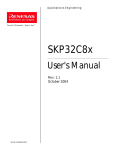


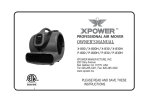
![[S3062PT-CPE] User`s Manual(Third Edition): CPE62PUE](http://vs1.manualzilla.com/store/data/005693507_1-69a1045bbc5cf41449359b406d2a53f2-150x150.png)
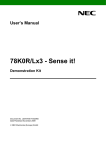
![[S3062PT-CPE-2] User`s Manual(First Edition): CPE62PSUE_2](http://vs1.manualzilla.com/store/data/005668190_1-0d028d6af383e5d06430420ca44dee4c-150x150.png)



